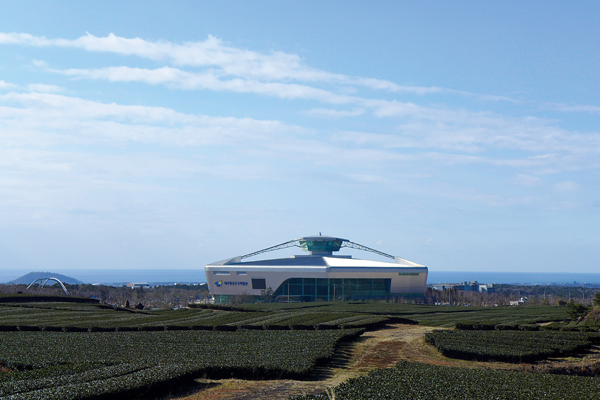| |
 |
|
| ▲ There are many decommissioned and replica aircraft on display at Jeju Aerospace Museum in southwest Jeju. Photo courtesy Jeju Aerospace Museum |
From the dawn of time human beings have gazed up at the sky in awe. It is a fascination that the new Jeju Aerospace Museum (JAM) aims to exploit by appealing to our curiosity of what is in, and flying through, the skies above.
The 115 billion won Jeju Free International City Development Centre (JDC) project took three years to complete and is the largest aerospace museum in Asia, with a total floor area of around 30,000 square meters.
In a grand opening on April 24, the museum in Andeok-myeon, Seogwipo City, added to Jeju Island’s already rich selection of museums and tourist attractions and The Weekly was given an exclusive tour.
The aim of the museum is “to create a place of education and awareness of the aerospace field,” and it certainly achieves that. An impressive array of galleries and informative exhibits document the history of aviation and space science.
The variety on offer provides good value for both adults and children: enough to inspire veteran pilots and budding young astronauts alike. It is an appropriate place for a field trip, a family excursion, or a day off work.
| |
 |
|
| ▲ A screen shot from Jeju Aerospace Museum's blog at jamblog.co.kr |
From the outside, the building resembles an angular, diamond-shaped space ship, and the futuristic glass and steel design seems to hover amid the well-sculpted green gardens and assorted decommissioned planes.
The first floor is the aviation section. Here the galleries explore the history of the Korean Air Force (KAF) and world aviation. Impressive displays include a selection of planes donated by the KAF and informative sections about aviation science and technology. Moving across the floor you encounter flight simulators and presentations that detail the design and function of plane and engine parts.
The fourth zone examines cutting-edge flight technology and applications in everyday life. Further towards the back of the building is the Smithsonian National Air and Space Museum’s “How Things Fly,” an exhibit provided by the American institution. A must-see facility for family excursions, it is educational and fun with bright, colorful, instructive demonstrations.
Further into the museum is the Space Exploration Section. Beautifully decorated, it offers outstanding and futuristic visuals; mouth-watering for any true sci-fi fan. The section unravels the secrets of the universe, detailing the history and the structure of space. A further ambitious exhibition speculates over the future of Space travel and exploration, whilst another details the incredible astronomical inge-nuity of our ancestors.
| |
 |
|
| ▲ The museum is located in some of the most beautiful Jeju countryside which can be appreciated from a top-floor viewing platform. Photo courtesy Jeju Aerospace Museum |
The real highlight of the museum though is the “Circle Vision 5D Cinema.” A 360-degree screen allows you to wander at your leisure and encounter virtual reality from all angles, while smoke and wind sensations intensify a unique and original experience.
Other museum features include a virtual planetarium, the Aries educational area – a kind of high-tech classroom – and Procyon, where par-ticipants create cartoonish avatars and have them socialize together on an interactive wall. The museum also includes an auditorium and conference room, food courts, restaurants and facilities for young children.
Located in the southwest of the island, the stunning scenery from the building's fourth-floor observatory is almost reason enough to visit. The view looks out towards Mt. Sangbangsan in the south, and the majestic Mt. Hallasan to the north. Flanked by the verdant greenery of O’Sulloc Green Tea Museum’s tea fields, Jeju’s renowned beauty is easily appreciated.
Tickets
Tickets to the three main themed rooms cost between 2,500 and 5,000 won. The "Big 3" all-in ticket allows access to all of these for a cheaper price than buying them individually.
|
|
Adult
|
Student/army
|
Children
|
Jeju residents
|
|
Individual
|
Group
|
Individual
|
Group
|
Individual
|
Group
|
Individual
|
Student
|
Child
|
|
Basic entrance
|
15,500
|
13,000
|
13,000
|
11,000
|
11,000
|
9,500
|
11,000
|
9,000
|
7,500
|
|
All-in ticket (“Big 3”)*
|
23,000
|
20,000
|
19,500
|
17,000
|
17,000
|
14,500
|
17,000
|
14,000
|
12,000
|
Hours:
Weekdays, Sundays and public holidays: 9 a.m. to 6 p.m.
Saturdays and high season (June. 20 to Aug. 31): 9 a.m. to 9 p.m.
*Closed: The first and third Monday of every month. If that Monday is a national holiday, the museum will be closed the very next working day.
Exhibitions: Last admissions one hour before closing.
Address: 217, Nokchabunjae-ro, Andeok-myeon, Seogwipo-City
Directions: Jeju International Airport → #755 → Get off at O’Sulloc Green Tea Museum [1 hour ] → Walk to Jeju Aerospace Museum [20 minutes]
Contact: 064-800-2000
|






















